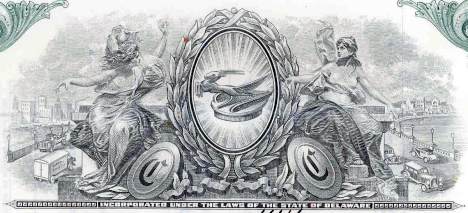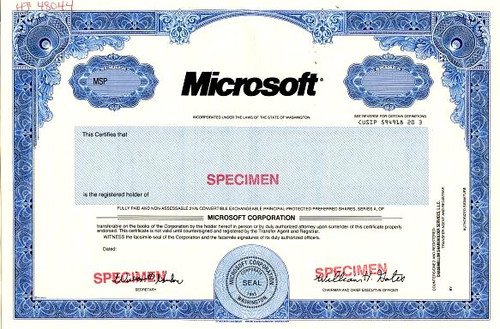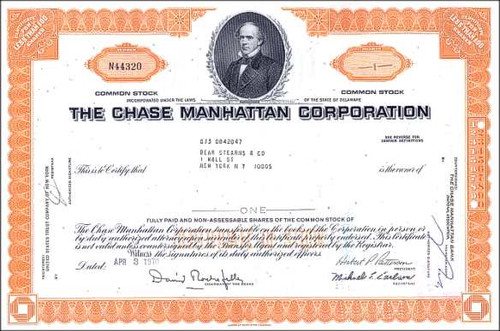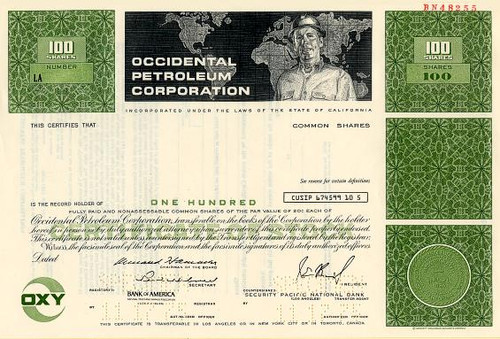Beautifully engraved stock certificate from the Chrysler Corporation issued no later than 1983. This historic document was printed by the Security-Columbian United States Banknote Corporation and has an ornate border around it with a vignette of allegorical woman by the company logo. This item has the printed signatures of the Company's Vice President and Chairman of the Board ( Lee Iacocca ) and is over 23 years old. 
Certificate Vignette Chrysler Corporation, founded on June 6, 1925, has a history as rich and colorful as that of its founder, Walter P. Chrysler -- a man so intrigued with automotive technology that he bought, disassembled and reassembled an automobile before he learned to drive. Walter Chrysler was born in Wamego, Kansas, on April 20, 1875. He began an ambitious career in the railroad industry as a machinist's apprentice when he was 17. Chrysler earned his master mechanic's papers in 1899 and nine years later, at the age of 33, became the youngest man ever to hold the post of superintendent of Motive Power for the Chicago Great Western Railway. When he joined the American Locomotive Company as manager of its Pittsburgh Works in 1910, his curiosity with the infant automobile industry led him to buy his first automobile, a Locomobile Phaeton. Two years later, Chrysler turned his fascination for automobiles into a career by joining the Buick Motor Car company in Flint, Michigan, as works manager. Buick became General Motors' first automotive division when GM incorporated in 1916. A year later, Walter Chrysler was named the division's President and General Manager. In 1919, in addition to his responsibilities at Buick, Chrysler became General Motors' first Vice President in charge of manufacturing. Financially independent at age 45, he retired from General Motors in 1920. But, within a year he was wooed out of retirement to become Executive Vice President of Willys-Overland which was in financial trouble. He was later hired to aid the ailing Maxwell Motor Car Company, Inc. He was named Chairman of Maxwell Motor Car's Reorganization and Management Committee and revitalized the company with the development of the Chrysler Six -- America's first medium-priced, high-styled automobile. By January 1924, Maxwell Motor Car had set an industry sales record when sales of the Chrysler Six reached 32,000 units. Chrysler Corporation was incorporated in Delaware on June 6, 1925, as a successor to the Maxwell Motor Car. Walter Chrysler became Chairman of the Board and President. In 1925, the company introduced the Chrysler Four, Series 58 with a top speed of 58 mph. More than one million people visited showrooms in the first four days the corporation displayed the new automotive wonder. By the fall of 1925, more than 3,800 dealers were selling Chrysler cars and, by 1926, the corporation had risen from 57th to fifth place in industry sales. Chrysler had expanded its operations to Canada as well. The Maxwell-Chrysler Company of Canada began in 1924 in Windsor, Ontario. The company incorporated as Chrysler Corporation of Canada, Ltd. in 1925. Windsor, an industrial city across the river from Detroit, quickly became Canada's largest automotive manufacturing center. In 1928, the De Soto and the first Plymouth -- priced from $670 to $725 to appeal to consumers with average incomes -- went into production in the United States. That same year, Chrysler bought Dodge Brothers, Inc., automotive builders with a solid reputation for making vehicles with rugged dependability. The Dodge Brothers became famous for building the first car to drive into and out of the Grand Canyon. By 1929, Chrysler had grown to become one of the Big Three leading automotive manufacturers. The company endured the Great Depression of the '30s through cost-cutting measures but never cut back on research and development. That decision paid off in 1933 when Chrysler became the only automotive company whose sales surpassed the record 1929 sales year. Chrysler's commitment to R & D in the 1930s resulted in several Chrysler engineering innovations including the patented "Floating Power," an engine mounting system which successfully isolated engine vibration away from the passengers and resulted in a smoother ride. In 1934, Chrysler introduced the Chrysler Airflow and De Soto Airflow vehicles, radically styled for their time with the industry's first one-piece curved glass windshield. Engineered for a smooth ride, the Airflow was equipped with Chrysler's first Automatic Overdrive Transmission. Chrysler continued to expand its operations by establishing Chrysler de Mexico in 1938 as an importer and distributor of Chrysler products. Subsequently, the company became an assembler and later a manufacturer of power trains. Chrysler de Mexico was controlled by Mexican capital until 1971 when Chrysler acquired majority ownership. Today, Chrysler de Mexico operates nine facilities in Mexico, including two vehicle assembly plants. Walter Chrysler led the corporation through the early years of innovation and North American expansion until he resigned the presidency on July 22, 1935. He remained Chairman of the Board until his death on August 18, 1940. He is remembered as an inspired entrepreneur and an early patriarch of America's automotive industry. THE WAR YEARS In the 1940s, American industry turned from consumer to defense production. Chrysler participated in may defense projects, most notably production of the 32-ton Sherman M4 tank. Chrysler produced 18,000 Sherman tanks, the main combat vehicle of the U.S. and its Allies in World War II. Approximately 500,000 Dodge trucks were also produced for the war. By 1945, Chrysler supplied more than $3.4 billion in military equipment to the Allied forces. After the war, Chrysler responded to the need for increased car and truck production by building or buying 11 plants between 1947 and 1950. In the 1940s, Chrysler introduced the Town & Country sedans, Station Wagons, and Convertibles... and began limited production of its first "hardtop" convertible in 1946. In 1951, Chrysler introduced the first production power steering vehicle. Their first key-operated ignition and safety-cushioned dash were other Chrysler innovations of the early '50s, as well as the Torsion-Aire suspension system in 1957. THE SPACE AGE K. T. Keller became Chairman of the Board on November 3, 1950, as Chrysler entered the space age by signing a contract with the U.S. Army to build the Jupiter space exploration missiles. In 1952, one of America's first successful space flights carried two monkeys to an altitude of 350 miles at the top of a Jupiter missile. When hostilities erupted in Korea in 1950, Chrysler again supplied military products including tanks, military trucks and air raid sirens. By the end of the Korean police action, Chrysler had participated in 31 government projects worth more than $1.1 billion. Chrysler's engineering department developed several landmark innovations during the 1950s including four-wheel, self-energizing hydraulic disc brakes and the famous "Hemi" V-8 engine. 1951 Chrysler "Hemi" Engine Chrysler engineers created the hemispheric combustion chamber V-8 engine, the Hemi, in 1951. The Hemi engine was a relatively expensive option for retail customers. Its costs often equaled a third of the purchase price of the car. Chrysler stopped producing the Hemi in the mid-50s due to the costs. However, in 1964, Chrysler introduced a high-powered sport version of the engine -- the legendary 426 Hemi -- with 425 horsepower under the hood. Richard Petty made the 426 famous in his NASCAR racing. Only about 11,000 of the specialty engines were built between 1964 and 1971. Car enthusiasts still consider the Hemi to be the ultimate internal combustion engine. Other Chrysler developments in the 1950s have become standard features on today's vehicles. The electric window lift system (1950), power steering and Oriflow shock absorbers (1951) made driving safer and easier. Drivers of Chrysler products built in 1955 were the first to enjoy the pleasures of Chrysler's all-transistor car radios. And, in 1957... curved side windows expanded the possibilities for automotive design. In 1960. after 33 years, production of the De Soto car line came to an end. The same year, Chrysler introduced the 45 RPM automotive record changer with 14 record capacity. Three years later, in 1963 Chrysler offered the industry's first 5 year or 50,000 mile warranty on drive train components. Chrysler experienced a number of transitions in the 1960s. On April 29, 1960, L. L. Colbert became Chairman of the Board, followed by George H. Love the next year on September 21, 1961 and Lynn A. Townsend on January 1, 1967. In 1963, under Love's leadership, Chrysler introduced the Chrysler Turbine. The vehicle was powered by a turbine engine, similar to today's jet engines. Only 50 of the vehicles were manufactured for consumer research and testing. The Turbine never went into full production, but the research results were incorporated into defense vehicle technology. Chrysler innovation continued in 1966, when engineers modified engines to create the Clean Air Package, an exhaust emission control system. The front seat shoulder harness and the separate, self-contained rear window heater/defroster system were among Chrysler safety innovations in 1966. As it became increasingly difficult to produce small cars in the United States profitably, Chrysler began importing and distributing small passenger cars and trucks built by its Japanese partner, Mitsubishi Motors Corporation. THE TROUBLED YEARS Chrysler set sales records in 1972 and 1973, but gasoline shortages, political uncertainty, high interest rates, severe inflation and weakening consumer confidence drove Chrysler into a financial crisis in the mid-70s. American consumer demand soared for smaller, more fuel-efficient cars. Japanese manufacturers were the first to respond, making great inroads into the U.S. market. The combined domestic market share of the total U.S. car market fell while the market share for imports rose to 23.4 percent. In the midst of the financial crisis, John J. Riccardo become Chairman on October 1, 1975. Responding growing economic trouble, Riccardo hired Lee A. Iacocca as Chrysler President on November 2, 1978. Ten months later, Riccardo resigned and Iacocca was elected Chairman on September 20, 1979. Iacocca applied his experience of 32 years with Ford Motor Company to meet the challenge of rejuvenating Chrysler's sagging operations. Chrysler reduced costs, restructured its management and recruited new executives to deal with its serious financial problems. Despite these measures, external factors continued to limit Chrysler's ability to finance its programs fully. Chrysler was forced to seek assistance from the federal government in the form of loan guarantees. NO ACTUAL MONEY WAS EVER LOANED to Chrysler Corporation by the United States federal government... but many people are under the impression that they did. What the United States government did do, was "Guarantee" the repayment of the loans... should Chrysler Corporation fail. The United States government would eventually end up 350 Million Dollars richer for their help. In late December 1979, the U.S. Congress passed the Chrysler Corporation Loan Guarantee Act, which President Carter signed into law on January 7, 1980. The act provided Chrysler $1.5 billion in federal loan guarantees. Concessions from UAW-represented workers, white-collar employees, suppliers, creditors and lenders kept Chrysler operating despite record losses of $1 .7 billion in 1980. Chrysler cut inventories by $1 billion, reduced white-collar staff by 50 percent and cut its break-even point by 50 percent in its drastic efforts to manage finances. Through the travail, Chrysler doubled its corporate average miles-per-gallon (C.A.F.E.) and in 1978, introduced the first domestically produced front-wheel drive small cars -- the Dodge Omni and Plymouth Horizon. Chrysler was also the first American company to convert its fleet to front-wheel drive. Chrysler was on its way to recovery. RECOVERY AND GROWTH "If you can find a better car. . . buy it." This challenge became Chrysler's battle cry in its recovery fight. Lee Iacocca began appearing in Chrysler's television advertising in July 1980, and became one of the most recognizable businessmen in the world! In 1981, Chrysler reported record losses, but the company saw light at the end of its financial tunnel -- from the headlamps of its new K-cars. Developed on a limited budget, the Dodge Aries and the Plymouth Reliant, code-named the "K-cars", enjoyed sales success which Chrysler rode to profitability in 1982. The momentum continued, and for the first time since 1973, the company was profitable for four consecutive quarters. In August 1983, Chrysler paid off the federal loan guarantees seven years early, at a profit of $350 million to the U.S. government. In November 1983, production of Chrysler's minivans, the Dodge Caravan and Plymouth Voyager, began. The minivans created a new market segment and changed the way American families traveled. Minivans became Chrysler's best-selling vehicle and the company was well on its way back to economic health. More than a decade later, despite an onslaught of domestic and international minivan competition, Chrysler continues to dominate the U.S. minivan market and has captured more than 20% of Europe's minivan market. THE NEW CHRYSLER ACQUISITIONS AND EXPANSION Chrysler expanded into electronics and aerospace activities and enlarged its international operations in the 1980s. In 1984, the company reported its best earnings year ever and reorganized itself into a holding company made up of four operating divisions -- Chrysler Motors, Chrysler Financial, Gulfstream Aerospace and Chrysler Technologies. Chrysler continued its overseas expansion as it acquired 15.6 percent equity in Italian luxury car manufacturer Officine Alfieri Maserati SpA, in 1984. The relationship between Maserati and Chrysler ended in August 1988 and the equity was later sold. Chrysler later would build a joint venture 2 seat hardtop convertible (1989-1991) simply named the Chrysler Maserati TC. Chrysler and Mitsubishi Motors Corporation formed Diamond-Star Motors Corporation in 1985, as a joint venture company to manufacture small cars in the United States. Production of the Plymouth Laser started three years later in Normal, Illinois. The Eagle Talon, and Mitsubishi Eclipse were also built in the Diamond-Star plant. After a nine-year absence, Chrysler re-entered the European market in 1987 by exporting the Chrysler LeBaron (Convertible), the Plymouth Voyager, and the Dodge Daytona. All the vehicles were sold in Europe under the Chrysler badge. Later that year, Chrysler Motors purchased Nuova Automobili F. Lamborghini SpA, the maker of the famous Countach. Today, the Italian specialty automotive manufacturer produces the Diablo -- the world's fastest production automobile -- as well as other sports cars and high performance marine racing engines. Chrysler also made its biggest acquisition in 1987, purchasing American Motors Corporation, the fourth largest U S. automotive company. The $800 million acquisition included the world-famous Jeep®, three automotive assembly plants, 1,600 dealerships... and a joint venture operation, Beijing Jeep Corporation of Beijing, China. As a result of the acquisition, Chrysler launched the Eagle brand in 1987, the first new Chrysler brand since 1928 when Plymouth and De Soto were launched. Chrysler acquisitions and joint ventures in the late 1980s also included: 1987 Electrospace Systems, which manufactured and installed tactical and intelligence systems for aircraft, ships and missiles. 1988 A joint agreement between Flat and Chrysler to distribute Alfa Romeo vehicles in the U.S. and Canada. which ended in November 1991. 1989 A joint venture between Chrysler and General Motors called New Venture Gear -- the first joint venture between domestic automotive companies to make transmission components. 1989 Technologies Airborne Systems, to develop aircraft technology. 1989 Pentastar Transportation Group, Inc., which offers rental vehicles through: Thrifty Rent-A-Car System, Inc. and Dollar Rent A Car Systems, Inc. 1989 A joint venture agreement with Steyr-Daimler-Puch of Austria to build minivans for the European market. (Notice the name Daimler here!) PRODUCT DEVELOPMENTS IN THE '80s Chrysler continued its commitment to value and safety throughout the '80s. In 1987, Chrysler introduced an unprecedented 7-year/70,000 power train warranty and a 7-year/100,000-mile outer body rust protection warranty. The continuous-flow fully electronically-controlled fuel injection engine was a key product development in the early '80s. Chrysler became the first company to offer air bag restraint systems as standard equipment, in 1988. INTO THE FUTURE In the summer of 1989, Chrysler began a $1 billion cost cutting and restructuring program to focus its resources on its core automotive business. The restructuring led Chrysler to begin a new approach to car and truck production called "platform teams" where representatives from various departments -- such as design, engineering, purchasing, manufacturing and marketing -- work together on a single vehicle line through its entire life cycle. Each team functions like a small company with total operating responsibility. The team approach cuts development time, because everyone works together from the start. The Dodge Viper, a V-10 roadster, was the first vehicle developed by a platform team. Following the successful development of the Viper platform were the 1992 Jeep® Grand Cherokee and a new line of family sedans with innovative cab forward design: the 1993 Chrysler Concorde, Dodge Intrepid and Eagle Vision (commonly referred to as the "LH" cars). Lee Iacocca dedicated the Chrysler Technology Center in 1991, a 3.5 million square-foot megastructure on a site where the corporation's new world headquarters was scheduled to open at a later date. The facility supports cross-functional work among product design, engineering, manufacturing and other departments in vehicle development. In 1992, Chrysler dedicated the Jefferson North Assembly Plant in downtown Detroit, a $1.6 billion investment, including product development costs, to manufacture Jeep Grand Cherokee sport-utility vehicles. Chrysler built the plant in Detroit's inner-city to offer continued employment to its dedicated work force and to support Detroit, rather than following an industry trend toward building new assembly plants in rural sites. The year 1992 brought a changing of the guard at Chrysler. On March 16, the board of directors named Robert J. Eaton as Vice Chairman and Chief Operating Officer. Lee lacocca stepped down as Chairman and CEO on December 31, 1993, and the board elected Robert Eaton to fill the posts effective January 1, 1993. In 1994, Chrysler set a company record for U. S. retail sales and earned more money -- $3.7 billion -- than any other year in the company's history, including 1993, the previous record. That year also marked the introduction of the new sedans -- the Chrysler Cirrus and Dodge Stratus -- and the new coupes -- the Chrysler Sebring and Dodge Avenger. The Cirrus was named Motor Trend's "Car of the Year." In 1995, the Dodge Caravan, with the industry's first driver's side sliding door, became the first minivan to win Motor Trend's "Car of the Year" award. Overwhelming consumer demand for Chrysler's new cars and trucks spawned 19 separate sales awards in the same year. Chrysler continued its worldwide expansion in 1995, announcing plans to build a manufacturing plant in Argentina and invest $100 million in Japanese distribution. In May 1996, Chrysler began production of right-hand drive Neons for shipment to eight foreign countries, symbolizing its growing competitiveness in the global marketplace. On June 5, 1996, Eaton dedicated the Chrysler World Headquarters Building, a 15-story office complex crowned by a two-story Pentastar, attached to the Chrysler Technology Center. It is now possible for Chrysler Corporation to design, engineer, test, build, evaluate and develop marketing plans for its vehicles under one roof. These superior facilities have helped make Chrysler the lowest production-cost, highest profit-per-vehicle manufacturer in the industry! Today, Daimler-Chrysler's mission is to produce cars and trucks that people want to buy, enjoy driving, and want to buy again. With its award-winning vehicles, world-class facilities, and rapidly expanding share of the global market, Chrysler Corporation is closer than ever to accomplishing this goal. History from company press information.

Certificate Vignette













